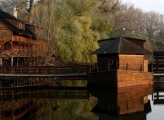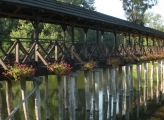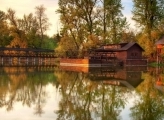Kolárovo
Kolárovo
Area: 106.823 km² (41 sq mi)
Population: 10747
Kolárovo (before 1948: Guta; Hungarian: Gúta or earlier Guta) is a town in the south of Slovakia near the town of Komárno. It is an agricultural center with 11,000 inhabitants.
The Town of Kolárovo (Gúta) is located in the Podunajská Lowland at the confluence of the Váh and Little Danube rivers.
The village was mentioned for the first time in the year 1268 and during its existence it changed its name several times (Stará Gúta, Veľká Gúta, Malá Gúta). In the past, Žabí hrad (Frog Castle) (Békavár) stood on the land of the village, according to some sources also called Békevár (Castle of Piece), which was built under the rule of the Queen Marry in the year 1349. Since 1551 the village developed as a fortified market town with the right of market.
History
Kolárovo belongs to the biggest towns of the lower part of the Rye Island (Žitný ostrov). It is spread on the junction of the Little Danube with the river Váh. The first village was called Little Guta and it was situated on the right side of the river Váh, next to the river Nitra. This settlement was also called Old Guta. It had been mentioned in the documents in 1268 for the first time.
In 14th century the second settlement called Big Guta was established. After the battle of Mohac the inhabitants of the two villages moved to a safer place being afraid of Turks, on the right bank of the Little Danube, to the Rye Island where the present Kolárovo is situated. In 1573 the village was plundered by the beg of Esztergon. At this time Big Guta had already been destroyed together with its old church, although the village had partially been protected by embankments which were a part of the fortress system of Kolárovo. The Kolárovo Castle was built in 1349 to protect fords and a business route. It was built upon the order of the Queen Mary and she named it Békevár (the Castle of Peace). In the bill by the king Ladislav IV. from the year 1551 villa Guta was already mentioned as a little town. According to the bill it was not only promoted to a town but it also obtained several privileges. According to a local tradition the kings of Arpád family populated surrounding abandoned villages by the Jazygs from the regions along the river Tisa. Folk habits or rustic buildings, etc. bear evidence of it. Yet other facts claim that the area of Kolárovo was donated by the king Ladislav 11. According to them it was the king St Ladislav, who delimited the area of the town with the extent of 56,000 acres by his bill. The king Ladislav 11. Kumánsky donated the surrounding hamlets to the village. Since that day the town was the property of the archbishop of Esztergon. The bill of 1268 bears the evidence of it. However, these landlords had never become favourite among the inhabitants of Guta who revolted from time to time, but also against other lords. The inhabitants of the town suffered a lot also during the war. In 1311 Chellus, an armiger of Matúš Čák of Trenčín, destroyed the villages of Guta, Nesvady a Zemné with his horde.
In 1669 Turkish units burned the eastern part of Kolárovo. Between 1848-1849 at the time of national-liberating fights, the retreating Austrian troops fired the town after the battles they had won at Tešedíkovo and Žihrác.
The fortress was built at the place of the castle of queen Mary. It plays and in comparison with the large fortresses in Nové Zámky and Komárno, it has always played less important role in the history. It has been repaired and renovated several times according to the period requirements. At the beginning of Turkish occupation the fortress was quickly repaired by the local captain Gregor Martonosi Pesthényi in 1527, to protect it from the approaching army of Ján Zápol'ský, supported by Turks. That year an army commander of Zápoľský, Gašpar Ráskay drew into Guta and conquered the town. Soon afterwards, the fortress fell into the hands of the imperial Austrian army again.
Between 1584-1594 the fortress was strengthened with the help of the Italian army engineers. At the time when Gabriel Bethlen was conquering the fortress in Komárno, local Walloon and French soldiers escaped. Between 1662-1664 being afraid of new attacks of Turks, the fortress was modernized again. Inside there were stone accommodation houses and stone stores for gunpowder and guns. At that time there were 130 mercenaries behind the walls under the command of Matej Fr?hwirtha. In the spring of 1707 at the time of Rákoczi upbringing, the count Quido Stahrenberg performed the fortification worth 6090 forints with the help of the army engineer Fischer.
The kuruc general Ján Bottyán stayed nearby the town for four times. On 12th July 1708 he conquered the fortress with the help of heavy artillery and captured local mercenaries. After fighting the fortress was destroyed and kuruc soldiers retreated with the words "Let it be the residence of frogs since now". Although the fortress was repaired later, its defamatory name Békavár (Frog castle) was preserved. Danish garrison was located there by general Heister. In 1840's the fortress had no importance, only the army of the general Görgeyho had a rest there after a lost battle.
Culturalsights
Roman catholic church of the Translation of the Virgin Mary was built between the years 1723-1724 in Baroque style at the place of the older burnt out Gothic church. In 1772 the building was enlarged. In the interior of the church there is a late baroque wagon vault. The altar painting on the main classical altar illustrates the translation of the Virgin Mary being a masterpiece of Ferdinand L?tgerndorff from 1832. There was older fortifying wall around the church with loopholes and round corner bastions from 17th century. However, the wall was unreasonably pulled down in the 50's of the 20th century.
The Holy Trinity Column is erected at the original spot in the church park and dates back to 1831. It was built to commemorate the victims of cholera. The statue of St Valentine is a folk work dating back to 1835 and was placed in front of the market entrance. Today after it had been removed several times it is situated next to the chapel. The Memorial of the World War I dates back to 1920's. The statue "Come up to me" is the work of Alojz Riegele. On the board there are the names of dead soldiers. The memorial of the people taken to the concentration camps in Dachau and Schonberg is the work of a folk artist. On the board of Reicher and constructor Štefan Lukačovič. The memorial was in 1965 originally situated next to the Municipality Office. The statue of Mother Earth is the work of the sculptor Ján Nagy. The fountain in front of the Municipality Office illustrates the unity during flood, the work called Outburst in front of the Municipality Office is based on the design of the constructor Paluš.
The memorial of the victims of the World War II. with the names of victims is situated in a new park. The tables on deportation in 1947 are on the statue of Mother and Child in the park of the health center. On the wall next to the entrance gate to the former cemetery there is a diploma by the sculptor Klára Pataki. The statue of a girl with a bucket situated in the area of the Slovak Primary School is the work of the sculptor J.V.Huck.




